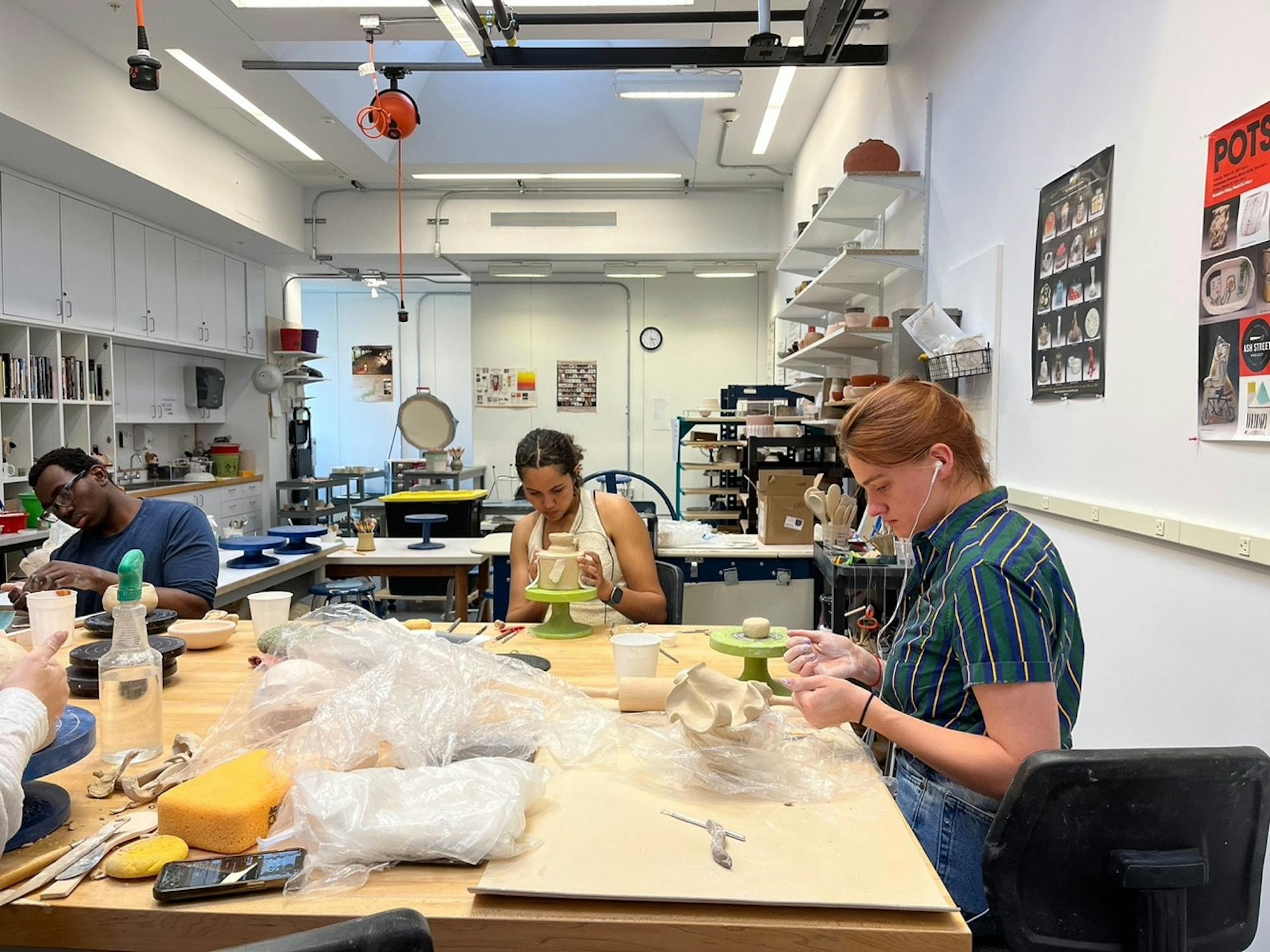The ceramics studio provides students with the opportunity to learn and enjoy the art of ceramics alongside like-minded artists. Located in room 333 of the Black Family Visual Arts Center, the studio offers a wide variety of tools for everything, from learning the basics to tackling more complex projects.
“Our program is based on teaching students the basic skills needed to understand the ‘language’ involved in creating a ceramic work,” studio director Jennifer Swanson wrote via email.
The program offers two-part classes aimed at teaching students the fundamentals of ceramics. The artists are simultaneously tasked with conceiving an artistic vision and executing it as a part of the ceramics process. The classes are instructed by Swanson and assistant ceramics director Sarah Heimann and are open to ceramicists of all levels — from beginners to advanced artists.
“[The instructors] don’t treat your work [as a beginner piece] just because you don’t have all the technical skills,” graduate student Larson Kaidel, a ceramics studio frequenter, said. “They honor what you want. They’ll ask, ‘What do you want this to look like? What things are you going for?’ Then they’ll take that and help guide you … so that you can achieve your artistic vision … It allows you to grow artistically as well as technically at the same time.”
This experience has proven to be rewarding in a variety of ways. For some students, the studio serves as a much-needed respite from the demands of academics.
“Being in that type of space is a break from the pace of everyday life because you have to slow down to focus,” Kaidel said.
Similarly, Maya Nguyen ’24 enjoys going to the studio because it feels like an escape.
“It’s really awesome to learn something new, [to] meet some awesome, nice, new people and also get away from school and my computer screen and academics — to sit down and do something tactile and artistic,” Nguyen said.
The ceramics studio was originally located in the Hopkins Center for the Arts; due to recent renovations, the studio moved to BVAC. There are obvious difficulties with the new studio — it is much smaller, limiting the amount of ceramic pieces and equipment that can be stored.
Further, the original kiln that was in the Hop has had to be completely revamped to fit in the new space. This change affects the entire process of creating pottery, not just the firing stage.
“It basically changes every possible outcome that you can think of. They have to use completely different glazes, completely different underglazes … It’s a totally different clay body that they’re using,” Kaidel said.
But even despite these challenges, artists, as always, find creative ways to problem solve. Kaidel even described the impact that the studio relocation had on her artwork as being “mostly positive” despite these challenges.
“It’s forced me to think about things that I hadn’t thought about and also try and use things that I hadn’t tried before … figuring out what was at the core of my artistic visions that I wanted to preserve and what was just an artifact of the materials that I was using,” Kaidel said.
The community of ceramicists at Dartmouth extend beyond the classes that are offered by in-house instructors and the projects students lead themselves. Because of Swanson and Heimann’s artistic connections, guest artists frequently attend the Dartmouth ceramics studio to teach students and showcase their artwork. One guest artist that has attended the studio was Yeonsoo Kim, who received an Emerging Artist of the Year award from the National Council on Education for the Ceramic Arts in 2020, according to his website.
The collaborations between artists extend to academics as well, allowing students to have hands-on experience with ceramics as part of their educational experience at Dartmouth.
“Each term we collaborate with academic classes on ceramic projects,” Swanson said. “This term we have been working with FILM 35: ‘Principles and Practice’ taught by Professor Jodie Mack and NAIS 30.08: ‘Contemporary Native American Art’ with Professor Jamie Powell. We have also collaborated with the Studio Art artist in residence Anna Hepler.”
Surrounded by artistic connections and instruction, students at the ceramics studio regard the space as a place to develop as artists and students, making it a highlight of their time at Dartmouth.
“Many of our students continue with ceramics after graduation and return, as alumni tell me how much they miss the studio and that it was one of the most memorable parts of their Dartmouth experience,” Swanson said. “This is extremely gratifying to me, as my favorite part of the program is seeing a student, even a novice, feel the thrill of discovering that they can make something handmade that is uniquely theirs.”
That ability to physically create something is what drew Nguyen to the studio.
“I feel like it is really awesome to tangibly hold something in my hands that I made and see the fruits of my labor and effort come through,” Nguyen said.
For all those eager to try their hand at ceramics, Dartmouth’s ceramics studio offers an accessible way to begin the process of actualizing their artistic vision.
“At the end of the term, you take home however many mugs that you have, and then every time you drink out of your mug, or every time you use or look at the flower vase … you get a reminder of the ability to create something in a peaceful way,” Kaidel said.
Correction Appended (Nov. 11, 12:01 p.m.): A previous version of this article stated that Yeonsoon Kim was a guest artist at the studio. The article has been updated to reflect the correct spelling, Yeonsoo Kim.




